
Traffic calming
Encyclopedia


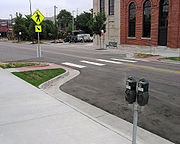


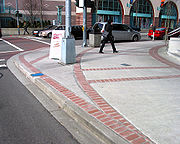
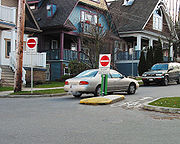
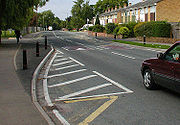
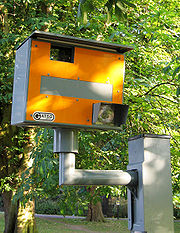
Traffic
Traffic on roads may consist of pedestrians, ridden or herded animals, vehicles, streetcars and other conveyances, either singly or together, while using the public way for purposes of travel...
in order to improve the living conditions for residents as well as to improve safety for pedestrian
Pedestrian
A pedestrian is a person traveling on foot, whether walking or running. In some communities, those traveling using roller skates or skateboards are also considered to be pedestrians. In modern times, the term mostly refers to someone walking on a road or footpath, but this was not the case...
s and cyclist
Bicycle-friendly
The term bicycle-friendly describes policies and practices which may help some people feel more comfortable about traveling by bicycle with other traffic...
s. Urban planner
Urban planner
An urban planner or city planner is a professional who works in the field of urban planning/land use planning for the purpose of optimizing the effectiveness of a community's land use and infrastructure. They formulate plans for the development and management of urban and suburban areas, typically...
s and traffic engineer
Traffic engineering (transportation)
For the engineering of communications and computer networks, see Teletraffic engineering.Traffic engineering is a branch of civil engineering that uses engineering techniques to achieve the safe and efficient movement of people and goods on roadways...
s have many strategies for traffic calming. Such measures are common in Australia
Australia
Australia , officially the Commonwealth of Australia, is a country in the Southern Hemisphere comprising the mainland of the Australian continent, the island of Tasmania, and numerous smaller islands in the Indian and Pacific Oceans. It is the world's sixth-largest country by total area...
and Europe
Europe
Europe is, by convention, one of the world's seven continents. Comprising the westernmost peninsula of Eurasia, Europe is generally 'divided' from Asia to its east by the watershed divides of the Ural and Caucasus Mountains, the Ural River, the Caspian and Black Seas, and the waterways connecting...
(especially Northern Europe), but less so in North America
North America
North America is a continent wholly within the Northern Hemisphere and almost wholly within the Western Hemisphere. It is also considered a northern subcontinent of the Americas...
.
Traffic calming was originally justified on the grounds of pedestrian safety and reduction of noise
Noise pollution
Noise pollution is excessive, displeasing human, animal or machine-created environmental noise that disrupts the activity or balance of human or animal life...
and local air pollution
Air pollution
Air pollution is the introduction of chemicals, particulate matter, or biological materials that cause harm or discomfort to humans or other living organisms, or cause damage to the natural environment or built environment, into the atmosphere....
which are side effects of the traffic. However, it is now recognized that streets have social and recreational functions which are severely impaired by car traffic. The Livable Streets
Livable Streets
Livable Streets is a 1981 book by Donald Appleyard in which he shows that streets have many social and recreational functions that may be severely impaired by high-speed car traffic....
study by Donald Appleyard
Donald Appleyard
Donald Appleyard was an urban designer and theorist, teaching at the University of California, Berkeley.Born in England, Appleyard studied first architecture, and later urban planning at the Massachusetts Institute of Technology. After graduation he taught at MIT for six years,and later at Berkley...
(circa 1977) found that residents of streets with light traffic had, on average, three more friends and twice as many acquaintances as the people on streets with heavy traffic which were otherwise similar in dimensions, income, etc. For much of the twentieth century, streets were designed by engineers who were charged only with ensuring traffic flow and not with fostering the other functions of streets. The basis for traffic calming is broadening traffic engineering to include designing for these functions.
Traffic calming measures
There are 3 "E"s that traffic engineers refer to when discussing traffic calming: engineeringEngineering
Engineering is the discipline, art, skill and profession of acquiring and applying scientific, mathematical, economic, social, and practical knowledge, in order to design and build structures, machines, devices, systems, materials and processes that safely realize improvements to the lives of...
, (community) education
Education
Education in its broadest, general sense is the means through which the aims and habits of a group of people lives on from one generation to the next. Generally, it occurs through any experience that has a formative effect on the way one thinks, feels, or acts...
, and (police) enforcement. Because neighborhood traffic management studies have shown that often it is the residents themselves who are contributing to the perceived speeding problem within the neighborhood, it is stressed that the most effective traffic calming plans will entail all three components, and that engineering measures alone will not produce satisfactory results.
Engineering measures
Engineering measures involve physically altering the road layout or appearance to actively, or passively slow traffic down. Measures include speed humpSpeed hump
A speed hump is a rounded traffic calming device used to reduce vehicle speed and volume on residential streets. Humps are placed across the road to slow traffic and are often installed in a series of several humps in order to prevent cars from speeding before and after the hump...
s, chicane
Chicane
A chicane is an artificial feature creating extra turns in a road, used in motor racing and on city streets to slow cars to lower speeds.- Motor Racing :...
s, curb extension
Curb extension
A curb extension is a traffic calming measure, primarily used to extend the sidewalk, reducing the crossing distance and allowing pedestrians about to cross and approaching vehicle drivers to see each other when vehicles...
s, and living street
Living street
A living street is a street in which, unlike in most 20th century streets, the needs of car drivers are secondary to the needs of users of the street as a whole. It is a space designed to be shared by pedestrians, playing children, bicyclists, and low-speed motor vehicles...
and shared space
Shared space
Shared space is an urban design concept aimed at integrated use of public spaces. It encourages traffic engineers, urban planners and experts from other fields to consult with users of public space when planning and designing streets and squares in both built and non-built environments...
type schemes. The town of Hilden
Hilden
Hilden is a city in the German state of North Rhine-Westphalia. It is situated in the District of Mettmann, west of Solingen and east of Düsseldorf on the right side of the Rhine. It is a middle sized industrial town with a forest and numerous attractions....
in Germany has achieved a rate of 24% of trips being on two wheels, mainly via traffic calming and the use of 30 km/h (20 mph) zones. As of 1999, the Netherlands had over 6000 woonerven
Woonerf
A woonerf in the Netherlands and Flanders is a street where pedestrians and cyclists have legal priority over motorists. The techniques of shared spaces, traffic calming, and low speed limits are intended to improve pedestrian, bicycle, and automobile safety.-By country:In 1999 the Netherlands had...
where cyclists and pedestrians have legal priority over cars and where a motorised speed limit of "walking speed" applies. However, some UK
United Kingdom
The United Kingdom of Great Britain and Northern IrelandIn the United Kingdom and Dependencies, other languages have been officially recognised as legitimate autochthonous languages under the European Charter for Regional or Minority Languages...
and Irish
Ireland
Ireland is an island to the northwest of continental Europe. It is the third-largest island in Europe and the twentieth-largest island on Earth...
"traffic calming" schemes, particularly involving road narrowings, are viewed as extremely hostile and have been implicated directly in death and injury to cyclists.
A number of visual changes to roads are being made to many streets to bring about more attentive driving, reduced speeds, reduced crashes, and greater tendency to yield to pedestrians. Visual traffic calming includes lane narrowings (9-10'), road diets (reduction in lanes), use of trees next to streets, on-street parking, and buildings placed in urban fashion close to streets.
Physical devices include speed humps, speed cushions, and speed tables, sized for the desired speed. Such measures slow cars to between 10 and 25 miles (15–40 km) per hour. Most devices are made of asphalt or concrete but rubber traffic calming products are emerging as an effective alternative with several advantages.
Traffic calming can include the following engineering measures:
- Narrower traffic lanes — streets can be narrowed by extending the sidewalk, adding bollards or planters, or adding a bike lane or parking. Narrowing traffic lanes differs from other road treatments by making slower speeds seem more natural to drivers and less of an artificial imposition, as opposed to most other treatments used that physically force lower speeds or restrict route choice.
- Curb extensionCurb extensionA curb extension is a traffic calming measure, primarily used to extend the sidewalk, reducing the crossing distance and allowing pedestrians about to cross and approaching vehicle drivers to see each other when vehicles...
s (also called bulbouts) which narrow the width of the roadway at pedestrian crossingPedestrian crossingA pedestrian crossing or crosswalk is a designated point on a road at which some means are employed to assist pedestrians wishing to cross. They are designed to keep pedestrians together where they can be seen by motorists, and where they can cross most safely across the flow of vehicular traffic...
s - Chokers, which are curb extensions that narrow the roadway to a single lane at points
- ChicaneChicaneA chicane is an artificial feature creating extra turns in a road, used in motor racing and on city streets to slow cars to lower speeds.- Motor Racing :...
s, which create a horizontal deflection causing vehicles to slow as they would for a curve - Allowing parking on one or both sides of a street
- Speed bumps, sometimes split or offset in the middle to help emergency vehicles reduce delay
- Speed humps, parabolic devices that are less aggressive than speed bumps and used on residential streets
- Speed tables, long flat-topped speed humps that slow cars more gradually than humps
- Speed cushions, a series of three small speed humps that slow cars down but allow emergency vehicles to straddle them so as not to slow response time
- Raised pedestrian crossingPedestrian crossingA pedestrian crossing or crosswalk is a designated point on a road at which some means are employed to assist pedestrians wishing to cross. They are designed to keep pedestrians together where they can be seen by motorists, and where they can cross most safely across the flow of vehicular traffic...
s and raised intersectionIntersection (road)An intersection is a road junction where two or more roads either meet or cross at grade . An intersection may be 3-way - a T junction or fork, 4-way - a crossroads, or 5-way or more... - Pedestrian refuges or small islands in the middle of the street
- Median diverters to prevent left turns or through movements into a residential area
- Changing the surface material or texture (for example, the selective use of brickBrickA brick is a block of ceramic material used in masonry construction, usually laid using various kinds of mortar. It has been regarded as one of the longest lasting and strongest building materials used throughout history.-History:...
or cobblestoneCobblestoneCobblestones are stones that were frequently used in the pavement of early streets. "Cobblestone" is derived from the very old English word "cob", which had a wide range of meanings, one of which was "rounded lump" with overtones of large size...
) - Additional give way (yield) signs
- Converting one-way streets into two-way streets
- Converting an intersection into a cul-de-sacCul-de-sacA cul-de-sac is a word of French origin referring to a dead end, close, no through road or court meaning dead-end street with only one inlet/outlet...
or dead endDead EndDead End is a 1937 crime drama film. It is an adaptation of the Sidney Kingsley 1935 Broadway play of the same name. It stars Humphrey Bogart, Joel McCrea, and Sylvia Sidney... - Boom barrierBoom barrierA boom barrier is a bar, or pole pivoted in such a way as to allow the boom to block vehicular access through a controlled point. Typically the tip of a boom gate rises in a vertical arc to a near vertical position. Boom gates are often counterweighted, so the pole is easily tipped...
, restricting through traffic to authorised vehicles only. - Closing of streets to create pedestrian zones
Enforcement and education measures
Enforcement and education measures for traffic calming include:- Reducing speed limits near institutions such as schoolsSchool zoneA school zone refers to an area on a street near a school or near a crosswalk leading to a school that has a likely presence of younger pedestrians. School zones generally have a reduced speed limit during certain hours.-Fines:...
and hospitals (see below) - Vehicle activated signVehicle activated signVehicle activated sign is a generic term for a type of road traffic sign which displays a message conditional upon the presence, or speed, of a road vehicle. These devices are used for speed limit enforcement at some locations in the UK....
, signs which react with a message if they detect a vehicle exceeding a pre-determined speed. - WatchmanWatchman cameraThe Watchman Casualty Reduction Scheme is a traffic calming measure used in the United Kingdom. The scheme comprises various methods to reduce traffic speed including cameras and Variable Message Signs which flash the speed limit when a driver is going too fast. The cameras do not issue fines or...
, traffic calming system
Speed limits
Speed reduction has traditionally been attempted by the introduction of statutory speed limitSpeed limit
Road speed limits are used in most countries to regulate the speed of road vehicles. Speed limits may define maximum , minimum or no speed limit and are normally indicated using a traffic sign...
s. Traffic speeds of 30 km/h (20 mph) and lower are said to be more desirable on urban roads with mixed traffic. The Austrian city of Graz
Graz
The more recent population figures do not give the whole picture as only people with principal residence status are counted and people with secondary residence status are not. Most of the people with secondary residence status in Graz are students...
, which has achieved steady growth in cycling, has applied 30 km/h limits to 75% its streets since 1994. Zones where speeds are set at 30 kph
30 kph zone
The 30 kph Zone, or 20 mph Zone, is a form of urban intervention where an area is designated with a 30 kilometer per hour limit, or 20 mile per hour limit. Note that 30 kph equals 19 mph, but 20 mph is more commonly used...
(or 20 mph
30 kph zone
The 30 kph Zone, or 20 mph Zone, is a form of urban intervention where an area is designated with a 30 kilometer per hour limit, or 20 mile per hour limit. Note that 30 kph equals 19 mph, but 20 mph is more commonly used...
) are gaining popularity as they are found to be effective at reducing crashes and increasing community cohesion. Speed limits which are set below the speed that most motorists perceive to be reasonable for the given road require additional measures to improve compliance. Attempts to improve speed limit observance are usually by either education, enforcement or road engineering. Education can mean publicity campaigns
Public service announcement
A public service announcement or public service ad is a type of advertisement featured on television, radio, print or other media...
or targeted road user training.
Speed limit Enforcement techniques include: direct police action, automated systems such as speed cameras or vehicle activated sign
Vehicle activated sign
Vehicle activated sign is a generic term for a type of road traffic sign which displays a message conditional upon the presence, or speed, of a road vehicle. These devices are used for speed limit enforcement at some locations in the UK....
s or traffic lights triggered by traffic exceeding a preset speed threshold. One cycling expert argues for placing direct restrictions on motor-vehicle speed and acceleration performance. An EU report on promoting walking and cycling specifies as one of its top measures comprehensive camera-based speed control using mainly movable equipment at unexpected spots. The Netherlands
Netherlands
The Netherlands is a constituent country of the Kingdom of the Netherlands, located mainly in North-West Europe and with several islands in the Caribbean. Mainland Netherlands borders the North Sea to the north and west, Belgium to the south, and Germany to the east, and shares maritime borders...
has an estimated 1,500 speed/red-light camera installations and has set a target for 30 km/h limits on 70% of urban roads. The UK has more than 6,000 speed-cameras, which raised more than £100 million in fines in 2006/07.
Europe
Traffic calming has been successfully used for decades in cities across Europe. For example, a living streetLiving street
A living street is a street in which, unlike in most 20th century streets, the needs of car drivers are secondary to the needs of users of the street as a whole. It is a space designed to be shared by pedestrians, playing children, bicyclists, and low-speed motor vehicles...
(sometimes known as Home zone
Home zone
Home Zone is a term used in the United Kingdom for a residential street or group of streets that are designed primarily to meet the interests of the local community, whether they are on foot, cycling, or in a car, enabling the street to operate primarily as a space for social use...
s or by the Dutch
Dutch language
Dutch is a West Germanic language and the native language of the majority of the population of the Netherlands, Belgium, and Suriname, the three member states of the Dutch Language Union. Most speakers live in the European Union, where it is a first language for about 23 million and a second...
word woonerf
Woonerf
A woonerf in the Netherlands and Flanders is a street where pedestrians and cyclists have legal priority over motorists. The techniques of shared spaces, traffic calming, and low speed limits are intended to improve pedestrian, bicycle, and automobile safety.-By country:In 1999 the Netherlands had...
, as the concept originated in the Netherlands
Netherlands
The Netherlands is a constituent country of the Kingdom of the Netherlands, located mainly in North-West Europe and with several islands in the Caribbean. Mainland Netherlands borders the North Sea to the north and west, Belgium to the south, and Germany to the east, and shares maritime borders...
) is a street in which the needs of car drivers are secondary to the needs of users of the street as a whole; traffic calming principles are integrated into their design.
North America
More recently, in response to growing numbers of traffic accidents and speeding problems, cities across North America have begun creating traffic calming programs to improve safety and liveability on residential streets. Many municipalities create asphalt or concrete measures, although preformed rubber products that are easier to install and consistently meet standardized requirements are becoming increasingly popular.Traffic calming studies
A Cochrane Review of studies found that there is evidence to demonstrate the efficacy of traffic calming measures in reducing traffic-related injuries and may even reduce deaths. However, the review found that more evidence is needed to demonstrate its efficacy in low income countries.According to economic commentator and smart growth critic Randal O'Toole
Randal O'Toole
Randal O'Toole is an American public policy analyst. Although O'Toole studied economics at the University of Oregon, he did not receive a degree in economics...
, the main goal of traffic calming is to increase congestion of motor traffic. He claims that some traffic calming measures such as reverting one way roads into two-way roads or creating "bump outs" have increased motor traffic congestion, resulted in more accidents and increased pedestrian fatalities. According to Florida urban planner Dom Nozzi "[c]ongestion is a powerful disincentive for sprawl; sprawl that steamrolls outlying ecosystems. With congestion, the sprawl market wither."
See also
- Hierarchy of roadsHierarchy of roadsThe hierarchy of roads categorizes roads according to their functions and capacities. While sources differ on the exact nomenclature, the basic hierarchy comprises freeways, arterials, collectors, and local roads....
- Low emission zoneLow Emission ZoneA Low-Emission Zone is a geographically defined area which seeks to restrict or deter access by specific polluting vehicles or only allow low emitting vehicles, such as regular or plug-in hybrids, or zero-emission vehicles, such as all-electric vehicles, with the aim of improving the air...
- PedestrianPedestrianA pedestrian is a person traveling on foot, whether walking or running. In some communities, those traveling using roller skates or skateboards are also considered to be pedestrians. In modern times, the term mostly refers to someone walking on a road or footpath, but this was not the case...
- Road traffic control
- Shared spaceShared spaceShared space is an urban design concept aimed at integrated use of public spaces. It encourages traffic engineers, urban planners and experts from other fields to consult with users of public space when planning and designing streets and squares in both built and non-built environments...
- Street hierarchyStreet hierarchyThe street hierarchy is an urban design technique for laying out road networks that exclude automobile through-traffic from developed areas. It is conceived as a hierarchy of roads that embeds the link importance of each road type in the network topology...
- Sustainable transportation

